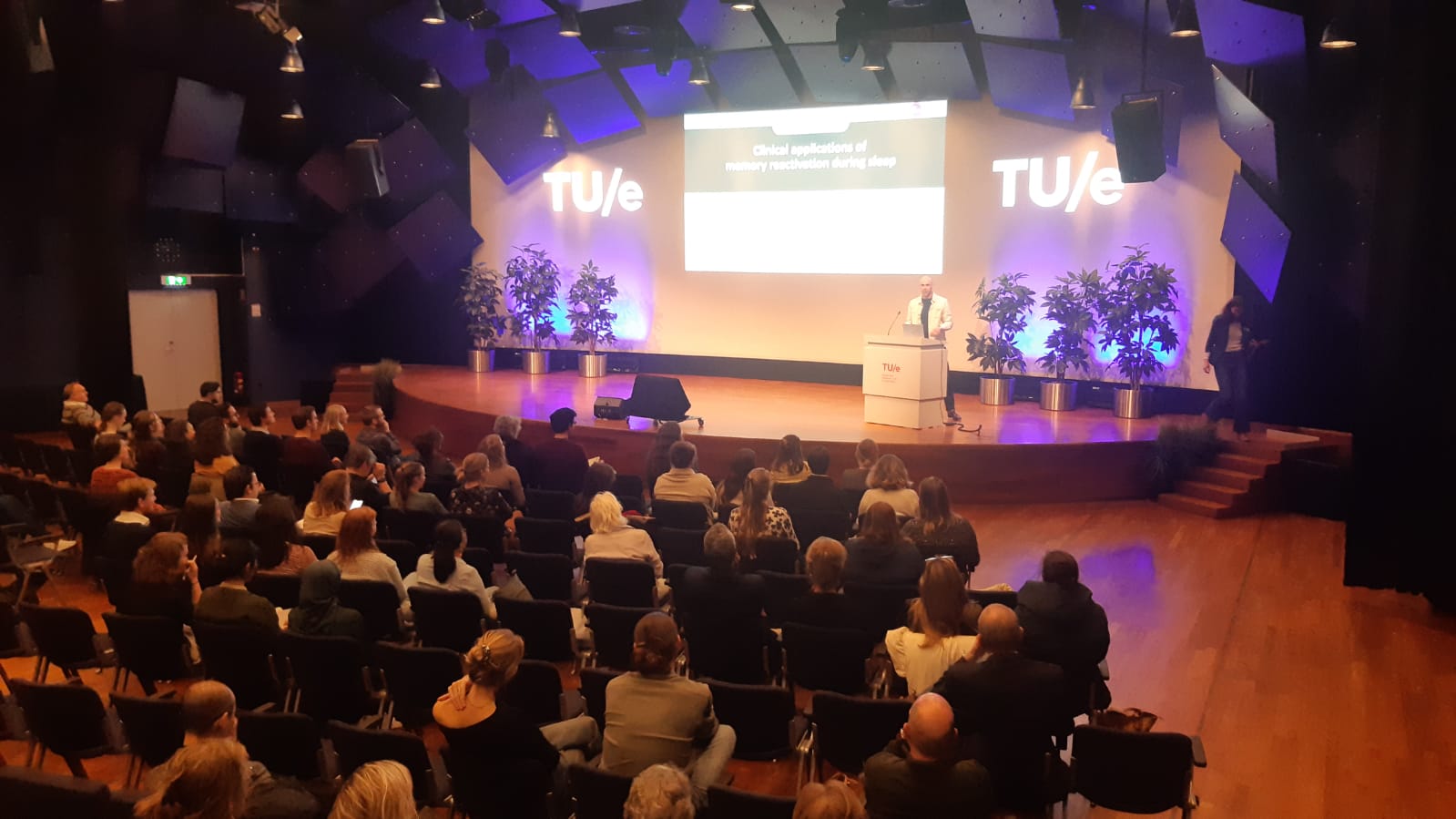
21 januari, 2025
During this year’s fall symposium, hosted at Eindhoven University of Technology, members of the NSWO and SVNL gathered to talk about new ways to identify and manipulate sleep.
Eight poster blitz candidates started the day off by showcasing that a little stress can enhance performance during their one-minute pitches. They introduced the audience to a few of many topics that were presented on an impressive total of 32 posters submitted to the symposium.
Manipulating sleep
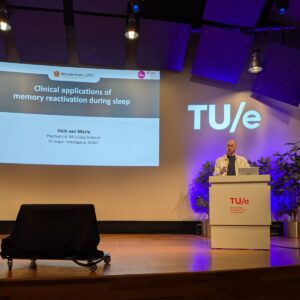 Stress was also the topic of the first speaker, Dr. Hein van Marle from Amsterdam University Medical Centre. He introduced the topic of targeted memory reactivation (TMR); a way to affect memory consolidation of a traumatic event by cueing associated stimuli during sleep. Targeting the up state of slow oscillations during deep sleep may enhance hippocampal-cortical consolidation while targeting the down state may block memory consolidation. One of our last speakers and winner of the Thesis Award, Dr. Christa van der Heijden, elaborated on this topic by showing her results in people with PTSD. Memory reactivation was associated with symptom relief and a temporary increase of deep sleep. Although the technique is promising, it needs further development for clinical application that works for complex memories. If your curious to read more about Christa’s Thesis, read this recent interview: Onderzoek: minder last van PTSS met ‘slaapgeluidjes’ | NSWO
Stress was also the topic of the first speaker, Dr. Hein van Marle from Amsterdam University Medical Centre. He introduced the topic of targeted memory reactivation (TMR); a way to affect memory consolidation of a traumatic event by cueing associated stimuli during sleep. Targeting the up state of slow oscillations during deep sleep may enhance hippocampal-cortical consolidation while targeting the down state may block memory consolidation. One of our last speakers and winner of the Thesis Award, Dr. Christa van der Heijden, elaborated on this topic by showing her results in people with PTSD. Memory reactivation was associated with symptom relief and a temporary increase of deep sleep. Although the technique is promising, it needs further development for clinical application that works for complex memories. If your curious to read more about Christa’s Thesis, read this recent interview: Onderzoek: minder last van PTSS met ‘slaapgeluidjes’ | NSWO
Hereafter, Dr. Henry Hebron from the Netherlands Institute for Neuroscience in Amsterdam introduced us to the technical side of EEG analyses. He presented his work on using the EEG aperiodic slope as a better readout of vigilance state compared to periodic oscillations and the possibility of using this for its manipulation. The audience was able to discuss and consolidate the talk during a welcome lunch break with ‘worstenbroodjes’ (sausage rolls), a local specialty.
Identifying Sleep
After lunch, Dr. Pedro Fonseca and Dr. Merel van Gilst from our hosting facility Eindhoven University of Technology and Kempenheaghe in Heeze, opened the discussion on sleep scoring. They showed that we can use inter-rater disagreement as an advantage. For instance, when combining several (AI-based) scorings to generate sleep stage probabilities. . This enables the quantification of sleep stage ambiguity which can be visualized in a hypnodensity plot. AI-based scoring techniques can even help us to successfully classify sleep stages in patients with sleep disordered breathing, showing a high agreement with PSG in sleep apnea patients. The take home message? It is a great new way of looking at sleep patterns but we still need to better standardize things such as the color schemes of hypnodensity plots (a few attendees with color blindness couldn’t agree more with this last statement).
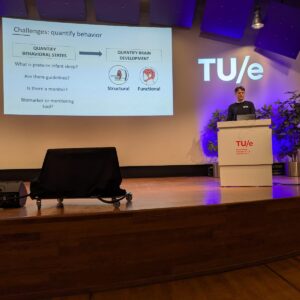
Correctly identifying (changes in) sleep stages is known to be complex but even differentiating sleep from wake can sometimes be difficult. Dr. Jeroen Dudink from the University Medical Center Utrecht explained that active sleep can look very similar to wake in preterm babies. Twitching movements provide an opportunity for sensorimotor integration and activity-dependent development of topography within the newborn red nucleus. They ‘dream for development’. To identify and score sleep in this very adorable group, heart rate and respiratory rate monitoring can estimate but additional video tracking for these specific movements increases accuracy. One challenge in video monitoring is that preterm babies often wear cute clothing with animal faces that trick the algorithm into looking at the wrong face, luckily this was easy to solve.
Hereafter, Dr. Myrthe Boss from Ziekenhuis de Gelderse Vallei, talked about sleep related to performance in athletes and shift workers. She presented many do’s and don’ts that were interesting to the (amateur) athletes and shift workers in the audience as well. After her talk many people literally said “throw me the microphone”, as the soft cube microphone available was swung across the room and boosted enthusiasm to engage in the conversation.
Early Career Scientists
Before the start of the key note lecture, three early career scientists were given the opportunity to present their work. Apart from Jaap van der Aar, who talked about the clinical purpose of hypnodensity analysis based on EEG and heart rate variability models specifically in REM behavior disorder, Alejandro Osorio-Forero and Mette Bakker presented on Noradrenergic mechanisms of cortical and autonomic (hyper)arousal and the effectiveness of low-dose amitriptyline and mirtazapine in patients with insomnia disorder (respectively). Two early career scientists were hereafter honored with a poster award. Tom Bresser won the Piet Visser Poster award that was handed out by a selected jury and Marieke Vringer received the public choice poster award. Congratulations to both of them!
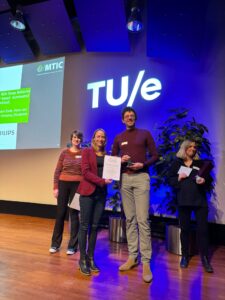
Tom Bresser – Piet Visser poster award
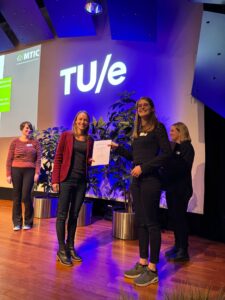
Marieke Vringer – public choice poster award
Keynote Speaker
Last but not least, Prof. Jean Louis Pépin from Université Grenoble Alpes flew in from France just in time to give his keynote lecture on new techniques to measure mandibular movements in patients with sleep apnea. Using these techniques, we are able to summarize the information needed to characterize sleep apnea severity and response to treatment. He provided the audience with yet another way to successfully identify sleep related patterns, apart from the PSG gold standard.
During drinks afterwards it quickly became clear that the symposium was well received by both basic and clinical researchers and health care professionals in the field of sleep. We thank Denise Bijlenga, Merel van Gilst, Lara Rösler, Mink Schinkelshoek and Jerryll Asin for organizing this inspiring day and look forward to next year!
Written by the NSWO PR committee
